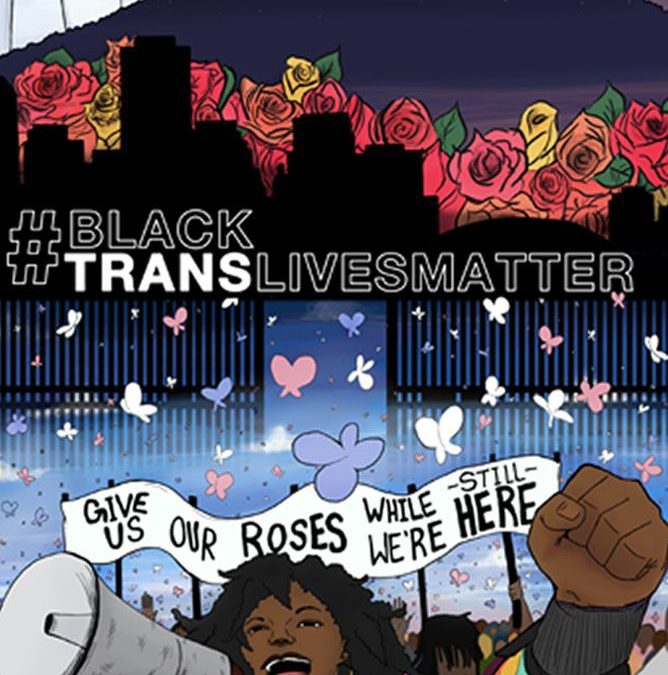In 1998, Gwendolyn Ann Smith sparked a campaign to recall the murders of two transgender women, Rita Hester and Chanelle Picket (who was murdered three years prior). These murders occurred in November and with the support of many activists from around the world, November 20th is now recognized as Transgender Day of Remembrance. As recognition of this day grew, the week prior to November 20th was declared “Trans Week” to raise awareness of transgender and other gender minority communities. This annual event has taken place for nearly two decades and the day itself has been adapted by some to also represent Transgender Day of Resilience. It is appropriate to use the hashtag, #TDOR, when referring to either the day of remembrance or the day of resilience on social media accounts.
The simultaneous existence of TDOR in both of its capacities is a necessary one. Transgender women of color are continuously targeted, assaulted, and even murdered at an alarming rate in the U.S. And yet many activists call out that it is not enough to simply mourn and hold vigils for those who have been targeted by hatred and intolerance. Instead, they argue that it is equally important to continue to uplift those who are survivors and as well as those who are thriving, as community members are able to serve as positive role models for others who may be facing similar challenges.
Social Change Consulting is committed to working with nonprofit organizations and foundations whose missions support disenfranchised minority groups from different backgrounds. And in recognition of the upcoming TDOR, we encourage our clients and partners to look inward first and consider what practical steps they can take to ensure that their own organizations, team members, and clients are both safe and included in programs and communications.
We are offering three simple tips that could be applied to different program areas. They are the (1) consideration of the use of gendered language; (2) training of staff; and (3) setting and striving for goals of inclusion.
Gendered Language
Gendered language is so embedded in our culture that most of us are often unaware of it. For example, your organization may be hosting a fundraising event and your Executive Director greets the audience with “Good evening ladies and gentlemen.” But with the growing awareness and diversity of gender minority people, your Executive Director may leave a nonbinary person feeling excluded by triggering an emotion of personal trauma associated with not “fitting in.” As another example, we may sometimes read an email from a new contact and without having met or talked to the person, make an assumption about the person’s gender. We then suddenly begin to use pronouns and titles that are gendered. In these examples, gendered language may lead to unintentionally offending someone. It only takes a bit of effort and practice to train ourselves to not make assumptions about another person’s gender identity based on ingrained social customs.
Training Staff
Diversity training for both new and old staff is always a good investment. Don’t wait until a minority person is hired or until a tragic event has occurred to educate and inform your staff. If your staff is trained periodically and frequently enough, it positions your team and organization to be prepared thought-leaders when it comes time to react to an internal or external event. Social Change Consulting is able to assist with diversity training in a broad range of topics and issues and is also able to make referrals to reputable clients and partners who we work with on various social justice issues. You can always visit our website to see a list of some of the different causes we support.
Goals of Inclusion
What goals do you and your team set in terms of diversity and inclusion? Have you ever made such a plan or goal? If so, when was the last time the topic was raised in a staff meeting? Goals for diversity and inclusion are also very broad, but it means there are many opportunities to pursue goals of inclusion. For example, your organization could make a commitment to gender diversity by reviewing gendered language in job descriptions and provide staff training to interviewers to ensure that interviewees are not misgendered. Or perhaps your organization could expand its audience and outreach to more diverse clients to apply for different grants and funding. Whatever the case, goals of diversity and inclusion simply means that you are consciously making room for someone, and when you’re making more room, you’re contributing to equity and growing your programs in meaningful ways.
If your organization has a question about TDOR or would like a recommendation on how it can show a message of support, do not hesitate to contact us at info@socialchangeconsulting.com.
Photo Credit: B. Parker

Adam (s/he, him) has a decade of nonprofit program experience working with immigrant and low-income communities. His areas of expertise range from refugee resettlement, legal advocacy, civil rights curriculum, LGBTQ organizing, and HIV education. Adam’s expertise lies in program development, implementation, and assessment. Adam is a foster parent and loves creating art. His small retail shop, The Garden Home, is a medium in which Adam can evolve and share his art.
